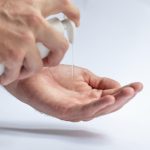Hey there, have you ever had a tear in your favorite sofa that you just can't stand to part with? Well, you're in luck because Loctite Vinyl Fabric Repair might be exactly what you need.
This quick-drying adhesive is designed to fix tears, cuts, and holes in vinyl and fabric, making it a potential game-changer for your beloved sofa.
In this guide, we'll take a closer look at how this repair kit works, whether it's suitable for your specific sofa, and the step-by-step process for using it effectively.
So, if you're ready to master the art of sofa repair, let's dive in and see if Loctite Vinyl Fabric Repair can bring new life to your torn sofa.
Key Takeaways
- Loctite Vinyl Fabric Repair is a quick-drying adhesive designed for vinyl and fabric surfaces, creating a strong and waterproof bond.
- Before applying the repair adhesive, thoroughly clean the torn area and follow the provided instructions for proper application.
- Assess the size, location, and severity of the tear to determine if Loctite Vinyl Fabric Repair is suitable, considering fabric type and alternative repair options.
- Using Loctite on your sofa can be an effective and cost-saving solution, but the repair may not perfectly match the color and texture of the sofa, requiring precision and patience during the application process.
Understanding Loctite Vinyl Fabric Repair
First, you'll need to understand how Loctite Vinyl Fabric Repair works to determine if it can fix your torn sofa. This repair application is designed specifically for vinyl and fabric surfaces, making it a potential solution for your torn sofa. The product effectiveness lies in its ability to create a strong, flexible, and waterproof bond that can withstand wear and tear.
To begin the repair process, you'll need to clean the torn area thoroughly to ensure proper adhesion. Once the surface is clean and dry, apply the Loctite Vinyl Fabric Repair according to the instructions provided. The product is formulated to dry clear, blending in seamlessly with the existing material for a discreet repair.
Understanding the ins and outs of Loctite Vinyl Fabric Repair will help you assess whether it's suitable for fixing your torn sofa. Keep in mind that the success of the repair also depends on the extent of the damage and following the application instructions diligently. If used correctly, this product can be an effective solution for addressing tears and damage to vinyl and fabric surfaces.
Assessing the Damage: Is It Suitable for Your Sofa
Assess the tear's size, location, and severity to determine if Loctite Vinyl Fabric Repair is suitable for your sofa. When assessing the damage, it's essential to consider the durability of the repair method in relation to the tear's extent.
If the tear is large, extending across seams, or if the fabric is severely worn, the repair may not hold up well over time. Additionally, consider the fabric type compatibility. Loctite Vinyl Fabric Repair is formulated specifically for vinyl and similar materials, so it may not be suitable for all fabric types.
If your sofa is made of a different fabric, it's crucial to explore alternative repair options that are better suited for the material. By carefully evaluating these factors, you can make an informed decision about whether using Loctite Vinyl Fabric Repair is appropriate for your sofa.
Doing so will help ensure that the repair is effective and that your sofa can be restored to its former glory.
Step-by-Step Guide to Using Loctite Vinyl Fabric Repair
To begin using Loctite Vinyl Fabric Repair on your torn sofa, follow these steps:
- Thoroughly clean the damaged area with a mild detergent and allow it to dry completely before proceeding with the repair.
- Apply the Repair Solution: Squeeze a small amount of the repair adhesive onto the torn or damaged area. Use a spatula or a small brush to spread the adhesive evenly over the damaged area. Be sure to cover the entire tear or hole with the adhesive.
- Press and Hold: After applying the adhesive, press the torn edges together firmly. Hold the edges together for at least one minute to ensure a strong bond. If the tear is large, use a piece of fabric or patch included in the repair kit to reinforce the repair.
- Allow Proper Drying Time: Let the repair solution dry completely before using the sofa. This usually takes about 24 hours. Avoid sitting or putting pressure on the repaired area during this time.
Common mistakes to avoid include applying too much adhesive, not allowing enough drying time, and not reinforcing large tears with a patch. Following these best practices will ensure the product's effectiveness and a successful repair.
The Pros and Cons of Using Loctite on Your Sofa
Is Loctite Vinyl Fabric Repair the solution you've been looking for to fix your torn sofa? Let's weigh the pros and cons.
One of the biggest pros of using Loctite is its effectiveness in repairing tears and holes in vinyl fabric. It's a quick and easy fix that can save you money compared to buying a new sofa. Additionally, Loctite is durable and can provide a long-lasting solution to your sofa woes.
However, there are some cons to consider. While Loctite can be effective, it may not match the exact color and texture of your sofa, which can be a downside for those seeking a seamless repair. Additionally, the application process requires precision and patience, as any mistakes can be difficult to reverse.
It's important to carefully consider whether the pros outweigh the cons for your specific situation. Overall, using Loctite Vinyl Fabric Repair can be a cost-effective and durable solution for repairing your torn sofa, but it's essential to weigh the potential drawbacks before proceeding.
Tips for Maintaining and Extending the Repair's Lifespan
Maintaining and extending the repair's lifespan involves following proper care instructions and avoiding harsh abrasives or chemicals that could compromise the adhesive bond.
When it comes to maintaining and extending the lifespan of your repaired sofa, here are some essential tips to consider:
- Gentle Cleaning: Regularly clean the repaired area with a mild detergent and a soft cloth to remove dirt and prevent the buildup of grime. Avoid using harsh abrasives or scrubbing vigorously, as this could damage the repaired area and compromise its durability.
- Avoiding Harsh Chemicals: Refrain from using strong chemicals, such as bleach or acetone, on the repaired section. These substances can weaken the adhesive bond and reduce the longevity of the repair.
- Protective Measures: Consider using furniture covers or strategically placing throw pillows to protect the repaired area from excessive wear and tear. This can help maintain the integrity of the repair and extend its lifespan.
Frequently Asked Questions
Can Loctite Vinyl Fabric Repair Be Used on Outdoor Furniture?
Yes, Loctite Vinyl Fabric Repair can be used on outdoor furniture, but there are alternative methods as well. It's important to consider the specific type of outdoor furniture and the extent of the damage for the best repair solution.
Will Loctite Vinyl Fabric Repair Work on Leather Sofas as Well?
Yes, Loctite Vinyl Fabric Repair can work on leather sofas. It's suitable for large tears and small rips in patterned, textured, and painted or dyed fabric. It's also effective for outdoor furniture.
Can This Product Be Used to Fix Large Tears or Only Small Rips?
Yes, Loctite Vinyl Fabric Repair can be used to repair large tears. Its durable formula and easy application method make it a great choice. Compared to other repair products, it has received positive reviews from customers.
Is Loctite Vinyl Fabric Repair Suitable for Use on Patterned or Textured Fabric?
Yes, Loctite Vinyl Fabric Repair is suitable for use on patterned fabric and textured fabric. The adhesive is designed to work on a variety of fabric types and can effectively repair tears and rips.
Can the Repaired Area Be Painted or Dyed to Match the Rest of the Sofa?
Yes, the repaired area can be painted or dyed to match the rest of the sofa. There are alternative methods to match the color, such as using fabric dye or vinyl paint for a seamless finish.
- Why Is Red Velvet Not Red? - April 25, 2024
- How Do You Describe Velvet Fabric? - April 25, 2024
- How Strong Is Velvet? - April 25, 2024








